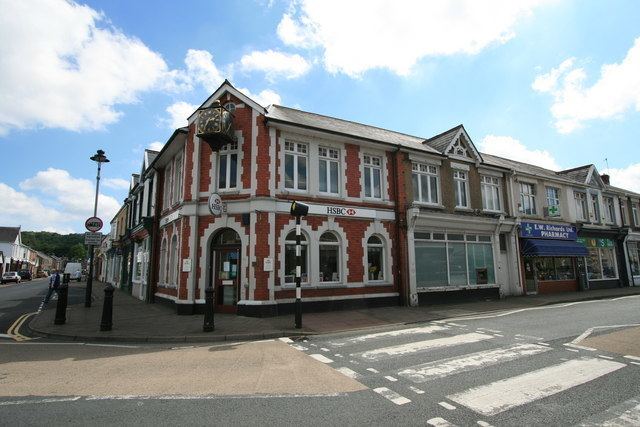OS grid reference SN793106 Country Wales Population 8,092 (2011) | Community Ystradgynlais Sovereign state United Kingdom | |
 | ||
Weather 11°C, Wind E at 13 km/h, 77% Humidity Points of interest Dan yr Ogof, Black Mountain, Sgwd Henrhyd, Fan Hir, Llyn y Fan Fach | ||
Ystradgynlais ([ˌəsdradˈɡənlais], /ˌʌstrədˈɡʌnlaɪs/) is a town on the River Tawe in southwest Powys, Wales. The town, which is the largest in the historic county of Brecknockshire and the second largest in the administrative area of Powys, grew around the ironmaking, coal mining and watchmaking industries.
Contents
Map of Ystradgynlais, UK
History
The place-name Ystradgynlais, meaning 'vale of the river Cynlais' - Cynlais may be a personal name, or derive from cyn ('chisel') and glais ('stream') - is first recorded in 1372. In the 1600s there were only a couple of houses by the church and a pub (now the rectory). In 1801 there were only 993 residents in Ystradgynlais living in only 196 houses. The first documented written evidence of iron working in the area was at Ynyscedwyn and is of a deed of release dated 1729. By 1750 there were only 7 furnaces in south Wales, one of which was at Ynyscedwyn.
The first written evidence of coal workings in the area was in 1780 in Wauclawdd. Most of the coal dug up in the area was sent to the blast furnaces of the iron works. By 1790 the full extent of the mineral resources in the valley were better known and it was realised that to exploit these to the full, improved transport would be essential.
The greatest increase in population was from 1821-41 which coincides with the coming of George Crane and the development of the Ynyscedwyn Ironworks. By 1870 however the area's industrial development was in decline due to various economic factors. Although coal mining carried on in the area a few light industries have replaced the heavy industries.
Culture
Ystradgynlais is one of the few areas within old Brecknockshire, which has a high proportion of Welsh-speakers, indeed, according to the 2001 census, over half of all the Welsh-speakers within Brecknock district live in Ystradgynlais itself.
Ystradgynlais hosted the 1954 National Eisteddfod, an annual Welsh festival of literature, dance, and music. The century-old award-winning Ystradgynlais Public Band competed in the 2005 National Eisteddfod.
Ystradgynlais's Parc-yr-Orsedd has a monument to the fallen heroes of both World Wars from Ystradgynlais, Abercrave, Cwmtwrch, Cwmgiedd, Glyntawe and Coelbren.
Dan yr Ogof caves are a short journey from the town centre, passing Craig-y-Nos Castle and country park. The caves are reputed to have once been the hideout of folk figure Twm Siôn Cati. Henrhyd Falls are also nearby.
Ysgol Maesydderwen is the town's secondary school. Ystradgynlais is also home to the Miners Welfare Hall, known and promoted as 'The Welfare', which plays host to a cinema. It also has a number of public houses.
In 2016 The Stephen Lewis Tristars Aquathlon in Ystradgynlais won the Welsh triathlon event of the Year 2016
Transport
National Cycle Route 43 passes by the southern edge of the town on the line of the former Swansea Vale Railway which linked Swansea via the Neath and Brecon Railway at Coelbren with Brecon. The A4067 road formerly ran through the town but was diverted in the 1970s onto a bypass route which largely follows the line of the former Swansea Canal.
Notable people
It is the home of Ystradgynlais F.C. and Ystradgynlais RFC. Ystradgynlais RFC was established in 1890; they hold a fierce rivalry with Ystalyfera RFC and Abercrave RFC. Players who represented their countries whilst playing for Ystradgynlais and notable players: Vernon Cooper, Anthony Buchanan, Steve Bayliss representing Wales; Jonny Koloi for Tonga, and Stan Wright for the Cook Islands.
Watchmaking
In 1946, Smiths Industries Ltd, Ingersoll Ltd and Vickers Armstrong founded the Anglo-Celtic Watch Co. Ltd., which produced watches on the Ynyscedwyn estate on the outskirts of Ystradgynlais. The factory was officially opened by Huw Dalton on 15 March 1947. Vickers Armstrong sold their shares to the other two companies in 1948. The Anglo-Celtic Watch Co. became one of the largest producers of watches in Europe, producing up to 1.25 million watches a year. Employees in the factory were said to be working in the 'Tic toc'. The factory closed in 1980.
